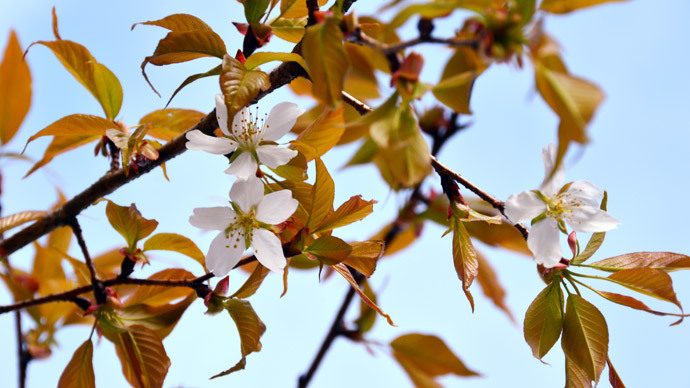
The 'extraterrestrial' cherry tree was expected to blossom in six years, in 2018, as normally it takes at least 10 years for similar sorts of tree to bear their first buds.
However, in April the 'space cherry tree', already grown to around 4 meters tall, suddenly produced nine flowers, reported local media. The blooms' form was also unusual as each had only five petals, while on the parent tree from which it was taken there were about 30 petals.
The wonder pit was one of around 265 seeds that were harvested from the fruit of the famous 1,250-year-old'Chujohimeseigan-zakura' cherry tree in the compound of an ancient Ganjoji temple. The tree is a variety of the'yamazakura' wild cherry species, and until now, the attempts to grow any sapling from its fruit have been unsuccessful.
The cherry seeds were sent to the ISS in November, 2008 with Japanese astronaut Koichi Wakata, now commander of the ISS. They were returned to Earth eight months later in July, 2009. A selection of seeds was soon successfully planted by Japanese botanist Takao Yoshimura near the ancient Buddhist Ganjoji temple in Gifu, central Japan.
"We are amazed to see how fast it has grown," Masahiro Kajita, chief priest at the temple, told AFP.
"A stone from the original tree had never sprouted before. We are very happy because it will succeed the old tree, which is said to be 1,250 years old," he added.
Meanwhile, the rest of space-traveling cherry pits were planted in Kochi Prefecture in south-western Japan and Yamanashi in central Japan, and they have already come into bloom as well.
The project, organized by Tokyo-based Japan Manned Space Systems (JAMSS), was aimed at letting children gather the stones and learn how they grow into trees and live on after returning from space, said Miho Tomioka, a spokeswoman for the project's organizer.
She said they, also along with children, who planted the seeds, were expecting the tree to blossom about 10 tears after planting in 2018 when the children who were planning these very trees come of age.

"We still cannot rule out the possibility that it has been somewhat influenced by its exposure to the space environment,"she said.
Plant physiologist Tomita-Yokotani says it is difficult to find an explanation to this rapid growth of the tree, adding that from a scientific point the researchers "can only say they don't know why [this rapid growth happened]."



This is the type of thing we should exploring space for.
What could this mean for gestation in space? Imagine humans having undergone their time in the womb while circling the BBM.
I'm sure it's either already been done or in the works.
Not that I find the exploration of space to be a particularly admirable pursuit, given all the problems which need attention from the best and brightest minds right here on the planet. But if it's going to be done ......